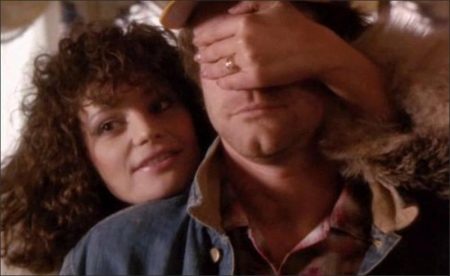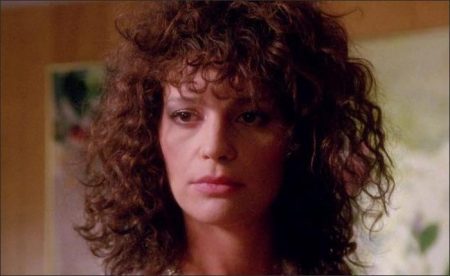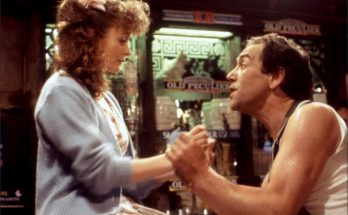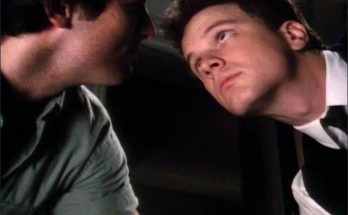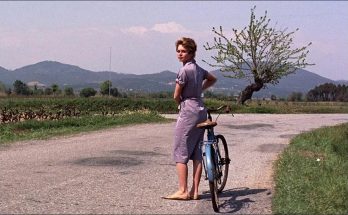White of the Eye movie synopsis. A series of murders of rich young women throughout Arizona bears distinctive signatures of a serial killer. Clues lead Detective Charles Mendoza to visit Paul White, a sound expert installing hi-fi systems in wealthy people’s homes. His special talent is to make a noise which echoes through the air cavities in his head and shows him where the sound of the speakers should come from and echo in the room. He is married to Joan, whom, ten years earlier, he had seduced away from Mike DeSantos, who was her current boyfriend. Joan is questioned by Mendoza, but does not believe his insinuations that her husband is somehow involved in the murders.
Various flashbacks show Joan’s previous relationship to Mike and later explain how it came to be that he abandoned her. The couple met Paul and befriended him. At Mike’s suggestion, he and Mike go on a deer hunting trip together. Paul shoots a deer and brutally mutilates it, demonstrating his sick fascination with killing. This is partly intended to scare Mike off, which it does. Mike catches Joan and Paul after they’ve made love, and Paul declares that he will take Mike’s place. “I am the one,” Paul says. Mike puts his gun at the back of Paul’s head but decides not to kill and abandons Joan.
By now Joan has run into Mike DeSantos working at a gas station in a neighboring town. Mike tells her he got out of prison after suffering a major head injury and he thinks life is looking up. He makes her promise not to tell Paul that she has seen him. Joan soon discovers Paul has committed adultery.
By puncturing Paul’s tires she provides him with an alibi for the most recent killing. He begs her forgiveness as the police turn their suspicions away from him. At home, Joan looks into a crawl space in the house, and discovers preserved body parts of Paul’s victims wrapped in paper and plastic. Joan confronts Paul, and Paul tries to explain his motivations for killing. He believes he has been “chosen” and is expressing the nothingness of the universe, whose heart is female and destructive like a black hole. He is putting women “out of their misery,” but he loves Joan.
White of the Eye is a 1987 British thriller film directed by Donald Cammell and starring David Keith and Cathy Moriarty. It was adapted by Cammell and his wife China Kong from the 1983 novel Mrs. White, written by Margaret Tracy (pseudonym of the brothers Laurence and Andrew Klavan).
Film Review for White of the Eye
Beaten in the elusive, uber non-prolific stakes only by the equally mysterious and fascinating Terrence Malick, Donald Cammell only managed to direct four films in over twenty years before he shot himself, White of the Eye being his fourth. Much like Performance, Wild Side and Demon Seed this film combines genres to trip up the audience, offering emotional intensity and prying character studies rather than genre conventions at all times.
Like the science-fiction dalliances of Demon Seed or the misleading crime path of Wild Side, White of the Eye sets up a fairly typical serial killer cum domestic melodrama with the smartly shot, voyeuristic set-pieces, tightrope balance of brutal slayings with household strife, and stark American dustbowl setting. However, Cammell only uses such conventions as a loose framework for another of his compelling and intimate examinations of people pushed to the edge, characters permanently viewed at breaking point, in the most extreme situation.
What’s most refreshing and intriguing about White of the Eye though, is that its a film about psychosis, mortality and attachment that doesn’t choose sides. Its never didactic, it doesn’t moralise or resort to sentimental get-out-clauses and it forces the audience to identify with all its characters from all angles, whether that’s as victim or aggressor. That’s what’s so outlandish about White of the Eye, it manages to be universally subjective allowing everybody on screen to have glaring weaknesses as well as laudable virtues. Unfortunately, the tense build-up and unconventional cinematic style is somewhat betrayed by a dissatisfying conclusion that fails to explode as it should.
The film opens with the impressively eclectic score from Pink Floyd’s Nick Mason complimenting the scorched landscape and alienated characters. Although the setting isn’t as omnipresently oppressive as it is in say Seven or Don’t Look Now, the Southern locale lends a real sense of dormant menace waiting to be awoken (something awkwardly realised in the climax) using the sun-drenched expanse in a similar agoraphobic way as a more generic horror film uses the darkness to suggest claustrophobia.
Juxtaposing this isolation and disconnection with civilisation is the opening scene set in a thoroughly modern home as a rich woman prepares dinner on an immaculate table-top. A roving camera hints at an alien presence in the house, which is confirmed as an unseen attacker grabs this lone, unknown figure and tosses her about the kitchen smashing and spilling her neatly prepared meal.
Already at this point, Cammell’s vision is a very disorientating one, the intimacy of the ample extreme close-ups of panicked or alarmed eyes clashing with the docile sweeping aerial shots of the sandy emptiness, or the jarring modernity of the indoor architecture at odds with what’s lingering outside. The film immediately feels oddly alien and unfamiliar, a sensation it carries throughout.
This is another murder in a succession of homicides, and David Keith gradually finds himself caught up in the investigation, initially because of some distinctive tyre tracks, but increasingly so because of his erratic behaviour. Keith’s stereo-fitting technician is married with a child to Cathy Moriaty, and its this central relationship that provides the pivot for the film. How far can her devotion to this man be pushed as she gradually discovers (as do the audience) more and more about the darkness and uncertainty that lies just behind his masculine good looks and boundless affection?
Interspersed with the killings (which occur at seemingly random points in the Performance-style jumpy narrative) is a superbly acted relationship story about the uncertainty people encounter at tough times, the paranoia and tension instilled in simple everyday events and the mundane, banal side of conflict. Only these themes are taken to the extreme.
Another good thing about Cammell’s films is how he shows the oft-neglected human side of clichéd film situations, often crafting multi-dimensional and complex roles for women in genres where they’re so typically sketchy or perfunctory. The women in his films are often symbolic figureheads of the films spirit, and White of the Eye is no exception.
Like Anne Heche in Wild Side, Cathy Moriaty gives her best performance in this film, combining a steely determination with the emotional naïveté that her uncomfortable character needs. Her world-weary delivery of lines and suspicious eyes give the film a definite emotional intensity. For the most part, Cammell never loses touch with his characters, whilst the story sizzles away in the background, constantly threatening to break them apart but keeping this suspicion tantalisingly at arms length.
The conclusion is what lets the film down. In an effort to burst the screen with the pressure-cooker scenarios boiling over, the film hits a false note. Attempting to up the ante and offer an extreme and emphatic conclusion undercuts the human side of the story and thus the final fifteen minutes feel forced and unnatural. Which is a shame because the superb slow-burn set-up and intricate tone are marred somewhat by a histrionic ending that fails to either offer a satisfying exclamation mark or a resonance of lingering damage.
Ultimately, White of the Eye is a so idiosyncratically made, one uncertain development or uneven execution can put the film off balance. When the credits rolled, I wanted to feel repulsed or destroyed, but I only felt a little disappointed. After sixty minutes, these people’s lives mattered. An hour later, the distortion blurred my feelings, and even a notorious scene involving an unhinged man and a dead animal carcass couldn’t sway me.
White of the Eye (1988)
Directed by: Donald Cammell
Starring: David Keith, Cathy Moriarty, Alan Rosenberg, Alberta Watson, Art Evans, Michael Greene, Danielle Smith, Pamela Guest, William G. Schilling, China Kong
Screenplay by: China Kong, Donald Cammell
Cinematography by: Larry McConkey
Film Editing by: Terry Rawlings
Costume Design by: Merril Greene
Set Decoration by: Richard Rutowski
Music by: Rick Fenn, Nick Mason
Distributed by: Palisades Entertainment Group (USA), Cannon Films (International)
Release Date: May 20, 1988
Visits: 97
